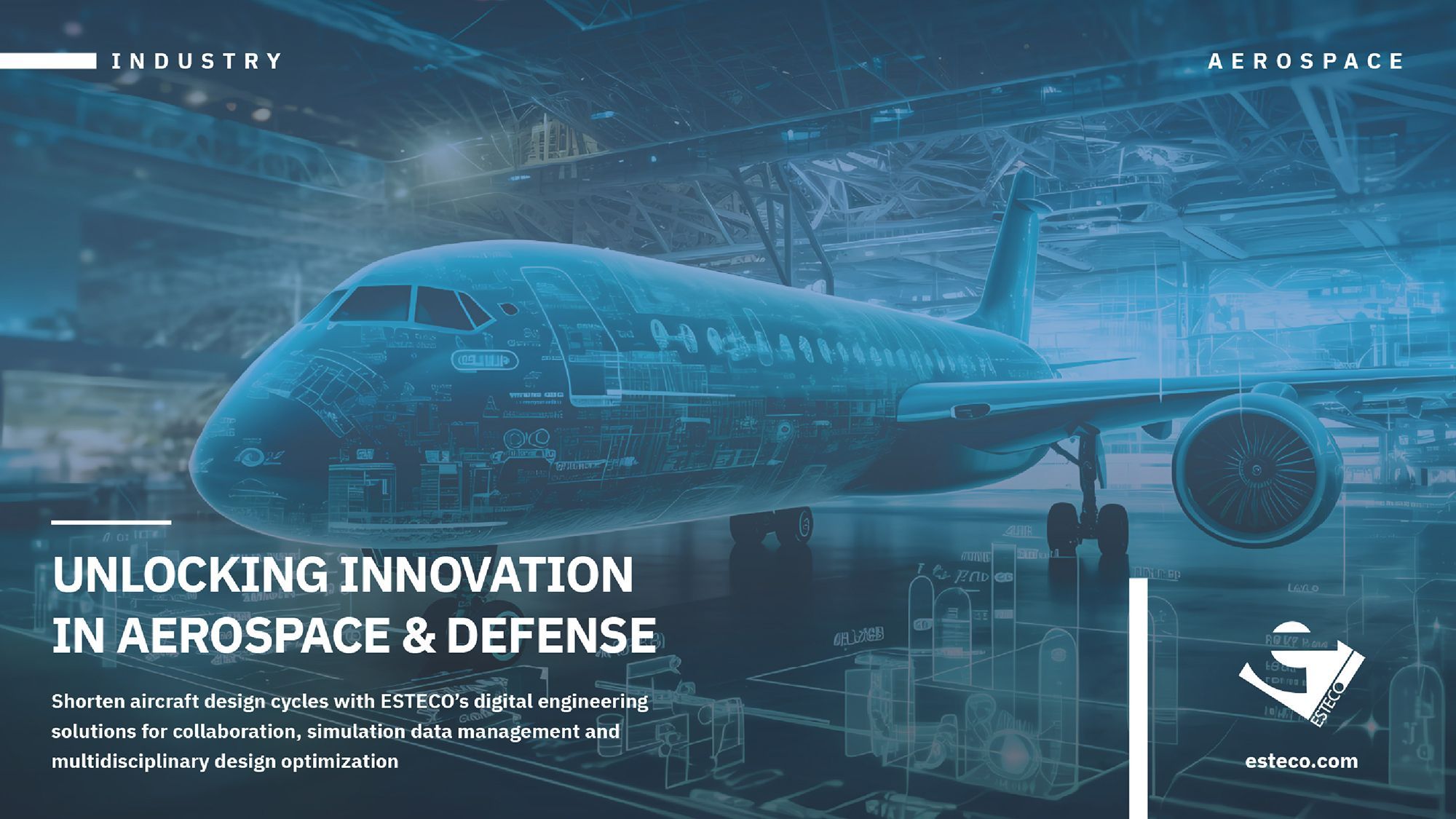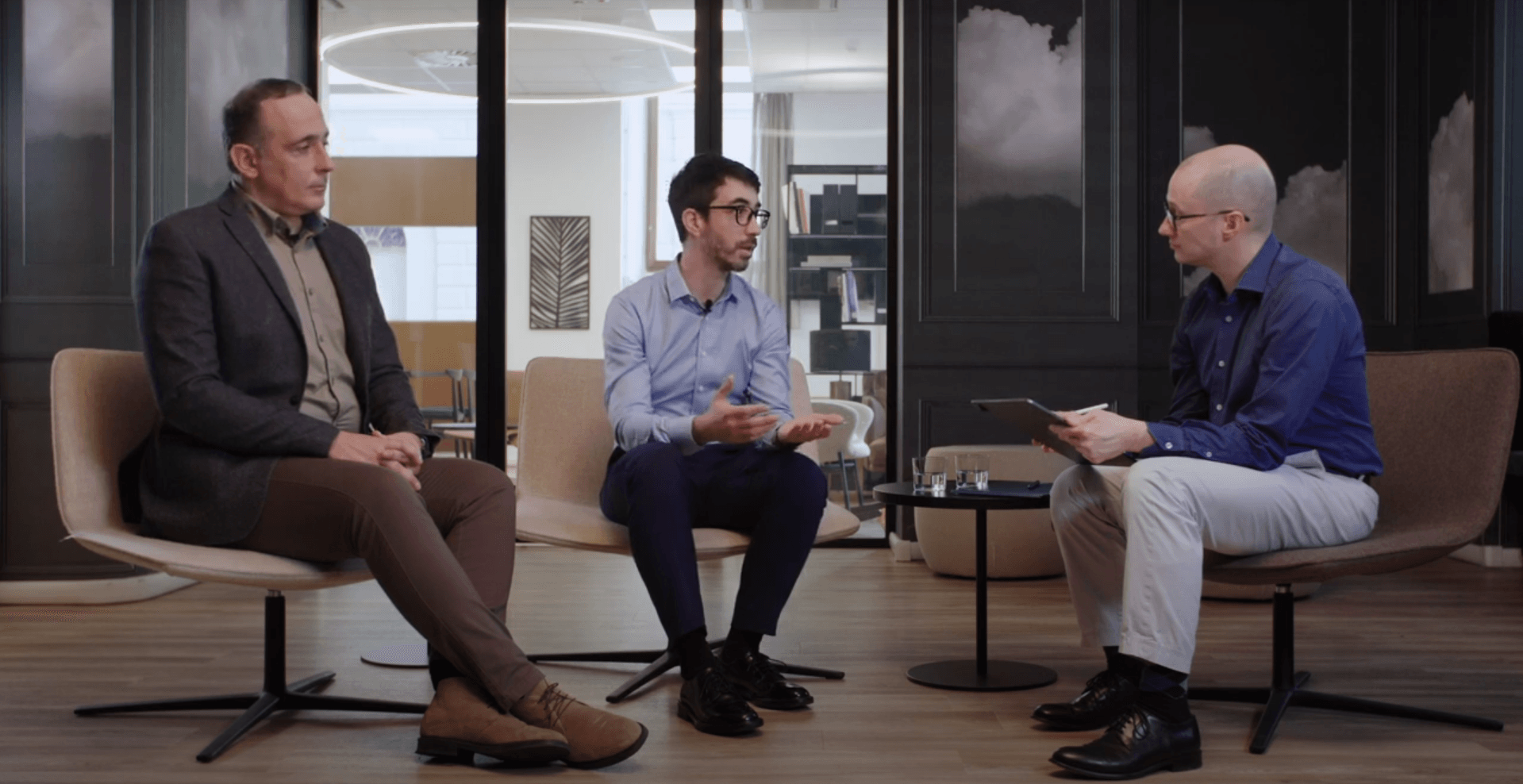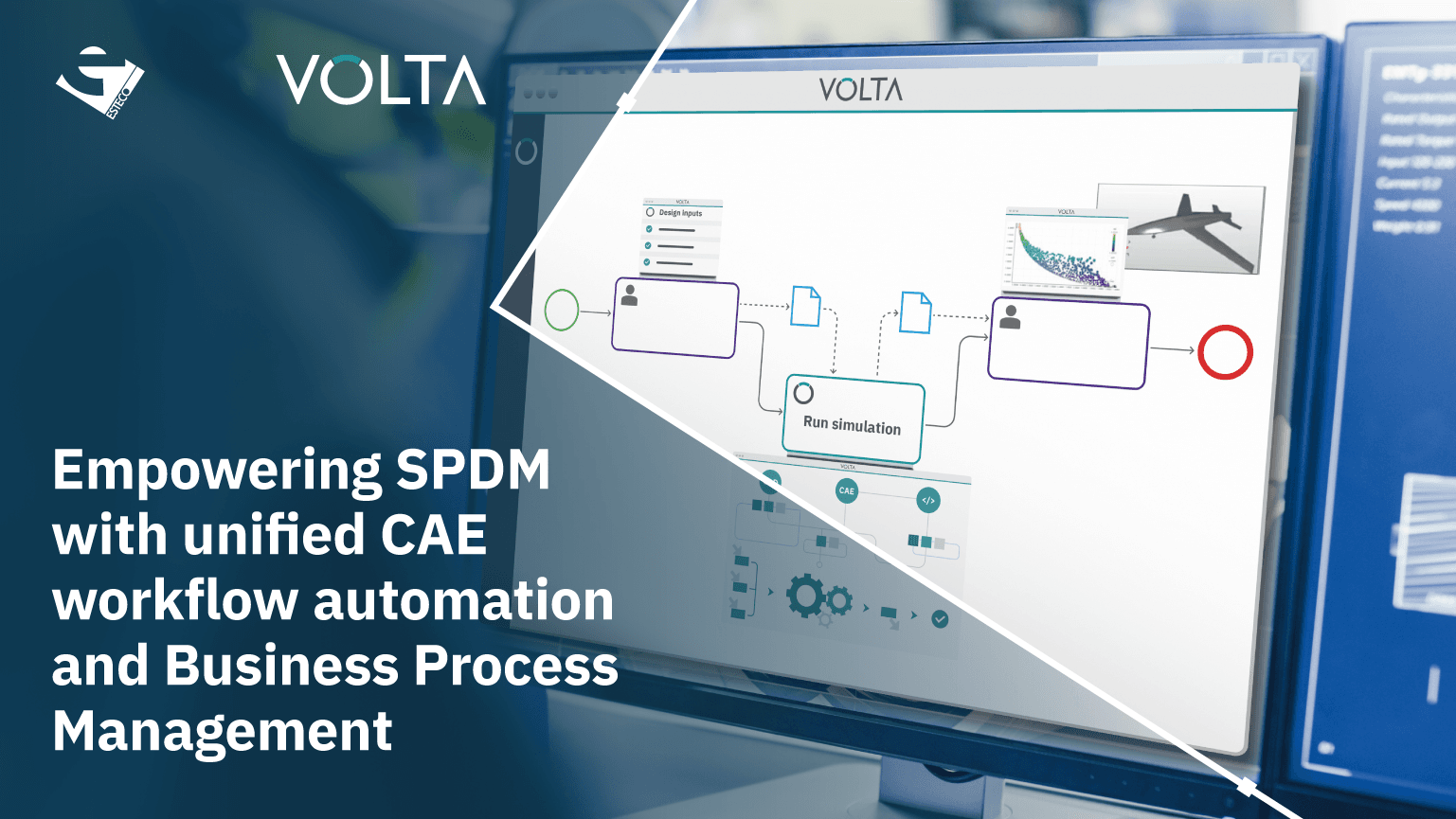eBook
Unlocking innovation in Aerospace and Defense
Shorten aircraft design cycles with ESTECO’s digital engineering solutions for collaboration, simulation data management and multidisciplinary design optimization.
Webinar
Empowering SPDM with unified CAE workflow automation and Business Process Management
Take a 30-minute deep dive into VOLTA BPM technology and learn how to automate human interactions and integrate simulation execution in a business process workflow.
Search results
Showing 1 - 5 of 5 results
Success story
Balancing multiple disciplines to design adaptable and sustainable buildings
Bouygues Construction develops innovation to support companies with new construction methods and materials, while considering future usages. The main requirements for a new construction include objective measures, flexibility, industrialization, collaboration and sustainability. Moreover, customers also ask for innovative and evolving buildings. Bouygues keeps developing innovative processes together with a collaborative Multidisciplinary Design Optimization (MDO) platform, which allows the various actors involved in the project to make quicker decisions and have a crystal clear overview of the possible solutions.
Cover image: courtesy of Bouygues Construction | Morpheus Hotel | credit photo Virgile Simon Bertrand (2018)
Challenge
A building is a prototype that is manufactured once. It’s not a functional project like a car or an airplane, where a design process can be profitable thanks to the sales volumes involved. On top of this, a building is created on site with local resources and labour, as well as environmental challenges that need to be taken into account. Engineers have to mix different disciplines such as cost engineering, methods, structure (reinforce concrete, steel, timber etc.), and building life cycle.
Bouygues Construction had to take into consideration a variety of disciplines and variables to optimize building performances and propose the most adapted design to its client. ## Solution
Bouygues has automated the design process of a building floor with modeFRONTIER, considering 26 input parameters such as geometry, solutions, usage specifications, structural dimensions, unit prices, and unit times of construction. The outputs were the costs, construction pace, carbon footprint.
Within the VOLTA collaborative platform, engineers succeeded in implementing different construction designs and provided the most profitable and the most sustainable solutions to the building team. This was possible thanks to the seamless integration of the simulation tools currently deployed at Bouygues. This was performed in as little as two days with one engineer. “The good software is the one the designer knows and masters - explained Sylvain Géry, Senior Structural Engineer at Bouygues Construction - ESTECO Technology can easily integrate with any simulation solver. This helps when a project involves different countries and enterprises who are used to working with different tools”.
Benefits
Thanks to the ESTECO Technologies for process automation, design optimization and simulation data management, Bouygues fastened the simulation process and reduced the overall design project time. Engineers built multidisciplinary processes and effectively coordinated all the phases involved. They could also assess the final design performance while considering costs and carbon footprint. Moreover, the collaboration between experts from different areas and the traceability of the simulation model evolution simplified the management of the project. In the building industry there are many construction options available. “Thanks to MDO, - Géry said - we could objectively quantify the benefits of the various construction types and identify the most appropriate combination of material usage, material technology and construction workers costs.”
Success story
Takenaka Corporation: from Integration to Collaboration in the simulation process
Discover how designers, engineers and managers benefit from ESTECO Technology to simplify their DESIGN&BUILD process. Using VOLTA simulation process & data management, and design optimization capabilities, they collaboratively assessed the performance of structural elements of a new company building to maximize office space capacity. ## Why Design&Build and Simulation Process and Data Management
Collaboration between design and construction has traditionally been playing an important role in the Architecture, Engineering, and Construction (AEC) industry. Takenaka Corporation, one of the top construction companies in Japan, ensures certified process and construction quality at the highest levels with its integral DESIGN&BUILD system. This methodology integrates architecture, building technology, and construction in a unified flow of work from concept through completion, replacing the traditional approach where the design and construction phases of a building project are carried out in a sequential manner.
The DESIGN&BUILD system leads to many advantages: effective communication, unified quality, effective timing and cost overruns, and reduced completion time. In fact, architects and engineers collaborate with each other, share data, and are updated on various requirements to deliver innovative building solutions and meet clients’ expectations. When Takenaka Corporation embraced the DESIGN&BUILD system, it looked for a reliable Simulation Process and Data Management (SPDM) platform. That is why they partnered with ESTECO to simplify the whole simulation design process, manage a huge amount of data across teams, and shorten product development time. Designers, engineers and managers involved in the architectural projects access ESTECO VOLTA from a web browser and intuitively interact with the simulation process. From running 3D building simulations to applying design optimization techniques, analyze results and share data on the internal cloud for collaborative decision making. ## Expanding 3D building modeling and design optimization techniques across the enterprise
Conducting manually parametric studies on 3D building models can become a time-consuming process leading to delays in project schedules. Overcoming these challenges for designers and engineers at Takenaka Corporation translate into an extensive use of ESTECO process automation, integration, and design optimization technology to significantly accelerate the architectural simulation design process. By combining modeling solvers as Rhino3D/Grasshopper, Abaqus, Midas iGen, or other in-house design software in modeFRONTIER powerful workflow, they can execute complex simulation chains and evaluate thousands of complex geometries in a short time. On top of that, applying ESTECO state-of-the-art design exploration and optimization algorithms to assess the correlation between several requirements (room size, thermal comfort, structural design to name a few) and maximize the building performance. At Takenaka, they had to make a step forward to expand the usage of 3D building modeling and design optimization techniques across teams with different expertise. Indeed, designers and engineers usually perform simple data analysis and are not necessarily confident in simulation and workflow set-up execution. Moreover, the DESIGN&BUILD methodology requires effective collaboration between the different actors involved in the simulation process to make changes and update their models for further analysis.
This gap has been filled by scaling up modeFRONTIER desktop solution capabilities across the enterprise with the ESTECO VOLTA collaborative web platform. It enables simulation experts to create and make the simulation workflow ready to be executed via web. Then, designers and engineers can use these simulation models, apply design optimization techniques, and analyze results in the VOLTA platform. Since the simulation data are accessible in their internal cloud, it is easier for them to quickly interact with the simulation experts asking for updated CAD/CAE models when design changes are required. In the end, managers can log in to the VOLTA web platform, access product performance metrics, and monitor the whole simulation product development advancements. This scenario has been successfully applied in the early design phase of a new office building project. VOLTA made simulation usable by different teams to optimize structural elements in order to guarantee maximum office space capacity.
Use case: rationalize the slab shape of an office building with VOLTA web collaborative platform
Expanding the usage of simulation and optimization became a true fact when Takenaka’s designers and engineers had to collaborate in order to assess the performance of structural elements for a new office building. The subcontracted project required to drastically reduce the number of columns to make the most of the office space. However, the expected distance between the columns is about 17 meters, which is quite a lot according to the Japanese regulations. This has an unavoidable impact on the flat surface of a slab, a common structural element used to construct floors and ceilings. The slab needs a proper curve in order to guarantee the stiffness. Although, a side effect of the increased curvature may unbalance the floor forces and cause local additional bending moments.
The solution is not just filling the curved slab shape, rather including massive amounts of ribs in some areas. To achieve this, the company’s designers and engineers combined the use of 3D building modeling techniques with ESTECO VOLTA collaborative web platform to explore reasonable volume amounts and coverage of the slab.
First, they used Rhino3D/Grasshopper to create and model the shape of the office building and then converted it (in Grasshopper) to be meshed in Midas iGen to perform structural analysis. In the end, the several outputs from finite element analysis such as maximum displacement and the stress were extracted by using a python script. The interaction between the different simulation solvers was automated in the modeFRONTIER workflow coupled within the ESTECO VOLTA platform environment. This enabled simulation experts to upload the modeFRONTIER workflow and execute it through a web interface.
Then, the structural engineers benefited from the VOLTA Advisor, a web environment for advanced post-processing and data visualization, to assess the simulation results from the finite element analysis model and validate the deformed shape of the all structure. For the same project, they also performed additional analysis through the VOLTA Planner dashboard, a modular interface to apply several optimization strategies in an intuitive way. This allowed them to easily create new simulation plans, change parameters bound, objectives and constraints with the aim of finding the best designs with minimized both the building weight and the maximum displacement of slab. “Thanks to the VOLTA HPC & Cloud capabilities, we were able to evaluate more than 700 designs in just four days. The VOLTA Player interface allowed to execute these computational heavy multi objective optimization analysis on the cloud without having to think how resources are used remotely”. Toru Inaba, Computational Design Group at Takenaka Corporation, also said that one of the key benefits of using VOLTA is to make simulation data accessible to a broader team of designers and engineers. “In particular,” concluded Toru Inaba, “our simulation experts could share the best practices on how to use the VOLTA Advisor, the web environment for advanced data analysis and visualization, with the structural engineers. The VOLTA web platform and its apps enabled us to truly democratize our DESIGN&BUILD simulation process. Designers and engineers can now access to the simulation results in one click and collaboratively take decisions without only relying on siloed reports of data”.
Success story
High-Rise Office Building
achieves zero energy use with
optimization-driven design technology
Evangelia Despoina Giouri, MSc graduated from the Faculty of Architecture and the Built Environment of Delft University of Technology, used modeFRONTIER to assess the energy performance and thermal comfort towards zero energy high-rise buildings. ## Challenge
Currently, 40% of the European Union’s final energy consumption and 36% of greenhouse gas emissions are attributed to buildings. New strategies to design nearly Zero Energy Buildings (nZEBs) are essential to meet climate targets set by the European Energy Performance of Building directive. This research applies process automation and optimization technologies to develop a new integrated simulation methodology to design nZEBs in a Mediterranean climate. This concept has been applied to a high-rise office building featuring photovoltaic panels integrated into the facade walls, located in the hot-dry climate of Athens, Greece. ## Solution
The goal is to define which construction parameters have the highest impact on annual energy demand and thermal comfort in the building. The simulation process was created in modeFRONTIER workflow coupling Rhino/Grasshopper modeling environment and EnergyPlus software to simulate energy consumption and daylight illuminance levels. Two optimization runs have been executed to investigate the influence of building parameters that can have a contradictory impact on cooling, lighting, heating energy loads, and four different facade orientations. ## Benefits
The genetic algorithm NSGA-II allowed performing 1000 evaluations in order to find the trade-off solutions for several design issues affecting energy performance and thermal comfort levels. “We were able to achieve 33% reduction on annual building’s energy consumption (from 109.12 kWh/m2 to 73.13 kWh/m2) compared to standard data provided by the current Greek legislation. Moreover, modeFRONTIER engineering and data intelligence capabilities enable us to visualize optimization trends and perform sensitivity analysis to assess the impact of the various facade parameters on the energy use and adaptive thermal comfort performance of the building” said Evangelia Despoina Giouri, MSc graduated from the Faculty of Architecture and the Built Environment of Delft University of Technology.
Success story
Takenaka Corporation automates simulation based architectural design
Takenaka Corporation offers comprehensive services worldwide across the entire spectrum of space creation from site location and planning to design and construction as well as building maintenance. Recently, structural engineers and computational architects at Takenaka Corporation Technical Research Institute have started to apply an optimization-driven design approach in their architectural and engineering projects with the aim of exploring and obtaining innovative design solutions in a shorter time. They chose modeFRONTIER software to optimize the 3D model of a new complex-shaped office building in Osaka, Japan. ## Challenge
Responding to a request of a client - a steel manufacturer - asking for a new office building featuring their fabrication technologies, Takenaka Corporation designed a steel pavilion-like office building which also facilitates and accelerates the communication between employees. Several requirements were considered to perform parametric studies on 3D building models: from maximizing the connections between rooms and expanding office space to designing a stunning atrium. Facing these challenges by manually conducting simulations is quite time-consuming, leading to delays in project schedules. Architects at Takenaka Corporation look at multi-objective optimization as an effective methodology to quickly generate creative and innovative designs while meeting client’s expectations ## Solution
The shape of the building was generated through the 3D Voronoi component available in Rhino3D/Grasshopper. The 3D geometry was integrated in modeFRONTIER workflow to automatically adjust the Voronoi parameters and slab levels, with the aim of optimizing conflicting outputs of the model (area of rooms, floor heights, connection between rooms, angle of surfaces) while also considering required room area and floor height as constraints. After performing an initial Design of Experiments (DOE) to assess the correlation between slab levels and other parameters, the optimization process was guided by the pilOPT algorithm available in modeFRONTIER to maximize the connection between rooms, minimize the sharp angle surfaces of office area and maximize the sharp angle surface of the hall. ## Benefits
“With modeFRONTIER, we run and evaluate 3000 designs in just one day instead of losing weeks doing it manually. Moreover, the easy to use interface and data analysis & visualization tools enabled our designers to process the results faster and select their favorite designs for further studies. Finally, we look forward to demonstrating the potential of combining modeFRONTIER workflow with BRAIN, our in-house structural design software that we use in most of our projects” said Takuma Kawakami, Structural Engineer and Computational Architect at Takenaka Corporation.
Success story
Multidisciplinary collaboration made easy at Airworks Engineering
Multidisciplinary collaboration made easy at Airworks Engineering
Airworks, a multidisciplinary company for mechanical engineering, was facing the challenge of improving efficiency in the conversion of wind energy into electrical power by optimizing the whole assembly of a wind power unit rotor. ## Challenge
Experts in wind power unit, specialists in CAD (Computer Aided Design) and CFD (Computational Fluid-Dynamics) professionals from different organizations were involved in a complex design scenario and needed to collaborate by effectively sharing a different kinds of information and resources. Engineers from the University of Trieste prepared the parametric CAD model and set up CFD simulations, while Airworks took care of aerodynamic performance calculations of the wind rotor blade, and subsequently performed optimization analysis with modeFRONTIER, the multidisciplinary optimization platform. The need for a common platform to share results emerged rapidly, and was successfully tackled with SOMO software solution (now evolved in VOLTA SPDM enterprise platform). This enabled the seamless execution of inter-organizational simulation workflows. ## Solution
With SOMO each partner of the simulation workflow was able to contribute to the project providing its own high level of collaboration. The CAD expert generated the geometry of the blades providing a parametric model and the CAD solution used to update it, while the CFD expert set up the aerodynamic simulation model, which used the geometry to evaluate the rotor aerodynamic performance. Both simulation workflows were made available to partners in a shared repository. Then the wind power unit expert was able to integrate his performance evaluation software into an automated multi-disciplinary workflow. Ultimately he used the workflow to evaluate the power efficiency of the system and to optimize it in a complete range of environmental conditions. ## Benefits
Through the entire process, simulation data and engineering knowledge were effectively managed and shared through SOMO, allowing a faster process and a considerable resource-saving”, says Stefano Picinich, Airworks Engineering Managing Director. With the set up of the optimization workflow, Airworks professionals were able to explore and evaluate new parametric geometry, leading to innovative designs, analyzed by the decision-maker via the post-processing tools. The considerable result was of a wind turbine design with an outstanding power coefficient and an annual energy production increase of respectively 1.26% and 0.47%.





